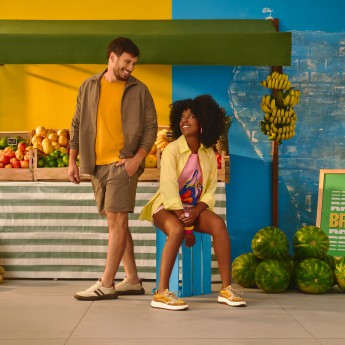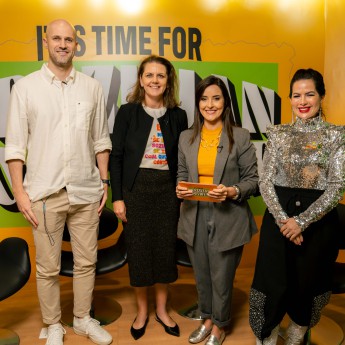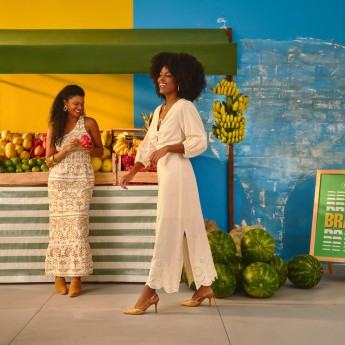Footwear companies out of the box
Producers of Brazilian shoes are prominent in the world in terms of design and authorial fashion
2021-11-11 | By Brazilian Footwear
 Footwear companies out of the box
Footwear companies out of the box
Often confused only with aesthetics, design covers, above all, functionality. In addition to offering beauty, the product needs to be useful, transform and facilitate people's lives. With the mission of protecting and beautifying the feet, the design of shoes has been evolving according to the needs of the market. In Brazil, which has the fourth largest footwear industry on the planet, the largest outside of Asia, it is no different. Favored by the facilities of having a complete and qualified production chain, producers of Brazilian shoes are prominent in the world in terms of design and authorial fashion.
The CEO of Abicalçados, Haroldo Ferreira, highlights that the national design of footwear is internationally recognized. "Brazil is a privileged country, for the creativity of its people, for the joy of colors and, in the case of footwear, for having one of the most complete and qualified production chains in the world. In here, we find both the qualified raw material and the required technological machinery for the construction of differentiated products”, evaluates the executive.
Ciao Mao
Design is in all niches of Brazilian shoe production. One of the positive and recognized cases both in Brazil and abroad is that of Ciao Mao. Founded in 2007 by designer Priscila Callegari, the brand from São Paulo was born from the restlessness of its founder. A designer by training, Priscila had already worked in several areas of Design (graphic design, visual communication, promotional architecture, and advertising creation). "Unlike the history of most creators and brands of shoe companies in Brazil, I was not born inside a shoe box and I do not have an academic background in fashion. I was only always interested in shoes and as a designer I saw them as a design object," she says, pointing out that she always admired models and brands that, even though they were created many years ago, remained relevant for generations.
In 2005, when she began to think about the creation of Ciao Mao, Priscila recalls that she did not understand at the time why Brazil, being an industrial hub for important footwear brands in the world, always sought creative inspiration in European and North American models. “To understand these and other issues, I decided to study shoes. I discovered how complex this industry was. Hundreds of processes, with great environmental and social impact, a lot of energy spent on the production of a single pair that, by the precepts of fashion at the time, would last only one or two collections”, she says. It was because of this necessity of the market that the designer created her own business.
Currently with four people to work on the development and creation of customizable and timeless footwear, Ciao Mao has its own store, national and international e-commerce, and wholesale for multi-brands. For the creative process, Priscila points out that the team has formed a “signal observatory”. “We analyze 'the spirit of time', the performance of our models, the comments and wishes of our customers, the new materials on the market, the materials left over from previous productions, etc. Everything has to make sense. If it does not make sense, there is no reason to make it,” she comments.
Priscila points out that, for production, the company has strategic partners who are in synergy with the purpose of the brand. Even not working with large volumes — the company produces about 400 pairs per month —, Priscila says that the partners have always been "seduced" by the project of producing differentiated footwear, with shoe lasts that can be used for various models, because they are customizable, and with leftovers and reusable materials. That is, exclusive shoes and for a specific niche, without the pressure for large production volumes. "We always emphasize that the most important thing would be to produce a high-quality product, with the best raw materials available on the market and that the production process would be as fair as possible, for the environment, for the industry, for the workforce involved and for the final consumer”, she comments. Raw materials that are responsible for much of the company's success. "As timelessness is one of our flags, quality, durability and comfort are key. We seek to work with materials that best suit each model and give preference to national suppliers which are socially and environmentally responsible”, she explains, adding that mixed-race leather and vacum, ecological fabrics and recycled rubber are used in the vast majority of models.
Matuschka Mia
Created in 2016, after identifying a gap in the footwear market, uniting quality, comfort and fashion, with many prints and colors for the little ones, Matuschka Mia, from São Paulo/SP, is another Brazilian success when it comes to design. One of the company's partners, Gabriela Matuschka, used her experience as a stylist for major women's brands and her market vision to unite beauty with comfort and quality, two attributes of the children's shoe market. Producing shoes with design for children, but aimed at everyone, the company bet on the adult fashion of animal print with noble raw materials, from leather to fabric, to attract not only the audience of 1 to 10 years, but their moms.
A partner of the company, Rafael Matuschka added to his sister's expertise with his Business Administration degree and the business took off. Since 2016, according to him, the company has been doubling its size every year. Even in 2020, while many companies suffered because of the pandemic, the brand grew more than 100%. In addition to the differentiated design, strategies that bet on the strength of e-commerce and the creation of a line for moms, in 2019, were fundamental to the brand's performance. "All our products were designed to attract the mother of the child, so we thought of making a line for this audience as well. We have extended the same grid to size 39 and we are having great results”, says Rafael.
With third-party production, Matuschka Mia values the creation of an exclusive product which is not determined by seasons. "We currently have ten people working just for creation, development and marketing. We conduct research on trends, market, but we always give a touch of our own to the creations”, says Rafael, highlighting that the company uses platforms such as Pinterest, Instagram, WGSM and the consumers themselves, which bring important feedback — which are carefully listened — to development. Identifying another market opportunity, about two months ago the brand launched a capsule collection of clothing, bringing the same motto of creation of footwear, with a lot of comfort and animal print, aiming at creating complete looks for moms and daughters. ”The product is being very well received and we will probably keep the creation", says Rafael.
The distinctive design of Matuschka Mia attracted international buyers. Rafael says that the company has chosen to participate in the digital platform BLANC Fashion in 2020, in partnership with Brazilian Footwear. Renewing its participation for the next edition, the company was sought by international buyers, especially from the United States, and was invited to attend a physical event in London last month. "We are already working in the United States and starting in Europe,” he celebrates.
Fabrès
Since 2013, Fabrès, from São Paulo / SP, has been on the market with a focus on luxury design in bags and shoes, all produced with sustainable exotic leathers. The company works with shoes in leather and leather soles, with the exception of sneakers and espadrilles, which have synthetic rubber soles. Research for development is carried out through fashion photos of the past, bringing affective memories to consumers, adding to these international trends, from arts and nature. As the company works with partners, there is still a great care for the choice of workshops trained for the production of bags and shoes with exotic leathers, which are different from vacum.
In multi-brand stores and e-commerce, the company suffered from the Covid crisis last year and seeks to get back on their feet. The owner of the company, Célia Fabris, says that there is a large luxury market in Brazil, but that was shaken by the crisis last year, especially given the restrictions imposed on physical retail, where a large part of the sales for this niche product happens. In addition, Célia says that with the pandemic, people have decreased the consumption of luxury products in general. “It's going to take a while for us to know where we're going and how we're going to get there. It is being quite difficult” she says, pointing out that if recovery from pre-pandemic levels is going to happen, it won't be until 2022.
Adriana Farina
Embroidery has been part of the life of Adriana Farina, from São Paulo and an entrepreneur since childhood. And it was from this creative activity that the eponymous brand was launched in 2019. The signed shoes have as their main highlight the compositions. And it is precisely from the embroidery and this handmade work that the creation of each model of a collection begins. As it happens with jewelry, the brand's shoe models use embroidery techniques, (crafts with beads/ beads), crochet, among others. "Adriana Farina was created from a self-questioning of how to incorporate embroidery into footwear. And I showed some creations to a consultant, and she advised me to follow this path,” says founder Adriana, adding that she has a very strong connection with Italian design.
One of the premises taken into account during the creative process of your collections is that footwear needs to be more perennial. ”A shoe of high added value with this well-crafted handmade work like mine, can not be fashionable for a season only", says Adriana, adding that among the materials used in her collections are Japanese and Czech beads, faceted and round crystals, creative threads, and natural raffia.
For the development of the collections, Adriana chooses a theme and begins the creation of the embroidery that represents elements contained in this theme. "I will always look for something in the world that gives me inspiration. For example, in my second collection I was thinking of something that flies and I developed a tribute to Italy naming the collection of Volare. In those models, I used butterflies, dragonflies, and dandelion flower”, she says, explaining that all creation is made in São Paulo. After making the “pilot embroidery”, Adriana gathers the team of embroiderers trained by her, which is composed of about 15 people, for the development of the embroidery.
With the embroidery completed, they are sent to Rio Grande do Sul, where the outsourced workshops in Sapiranga and Igrejinha apply and sew this embroidery on the shoes. A more complex embroidery can take a day and a half to finish. A simpler one can be done on an average of 54 pairs per day. "Every work has to have a research base, I do not copy any models, but I can analyze what I like to build. And the whole composition depends on the creation of embroidery”, highlights Adriana, saying that she hopes that manual work is increasingly valued because it is a way to leverage the economic power of a portion of the population, in addition to valuing the creativity of Brazilians.
Paula Torres
Graduated in Law, the Minas Gerais state native Paula Torres met an entrepreneur while still in college who would like to open a multi-brand shoe store. And it was because of this store in Rio de Janeiro that the founder of the brand Paula Torres got interested in the process of creating and manufacturing footwear to be able to answer to the desires of her customers. “I fell so much in love with the creation and manufacturing process that that retail environment no longer interested me. I moved to Sapiranga to learn more and started developing collections” says Paula, recalling that at first, as she no longer had the store, she rented a space in Rio de Janeiro to show her creations to other Brazilian fashion brands.
In 2011, the development of the Paula Torres brand began. "During the early days of the company, I was the only one responsible for the style area. And gradually, along with the growth of the company, the style area also grew. Currently, we have four people in the style unit and I am in a more managerial position, " she says, adding that the company has about 60 employees, between style, administrative and logistics, and the manufacture of shoes. Regarding the development of models, Paula points out that she had a habit of being present along with part of her team at all fashion weeks because cities breathe fashion in this period. "I like to go to museums and shops. Inspirations come from a snap, it will not come from a fashion show, but from a plant, an object. I always like to tell a story, and as I develop an authorial type of fashion, I try to follow a macro trend allied to styles that women want, with the DNA of Paula Torres, who also has Brazilian culture in mind.”
In her collections, she uses Brazilian raw materials and has quality and workmanship as top priorities. Materials such as goat leather, kid-skin and fabrics are used in her models, as well as PET bottles, for example, in the sustainable collections she is developing. With the manufacture of 40 to 50 thousand pairs per collection, totaling approximately 100 thousand pairs / year, the Paula Torres brand is growing. E-commerce, which today accounts for 40% of turnover, has exploded in the last two years and the number of stores, which today is eight, will increase by the end of the year. In addition, international e-commerce is also making deliveries to the whole world. "Brazilian design is very rich and we have to take care not to lose it. In addition, knowing how to put the DNA of each brand in the models is essential.



